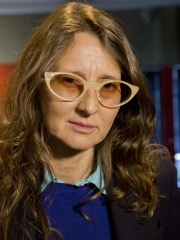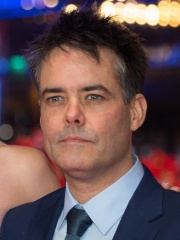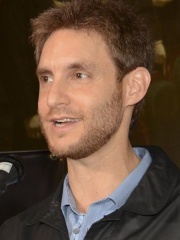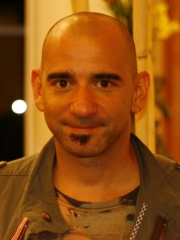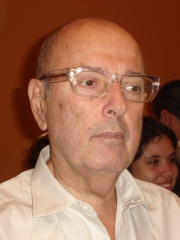
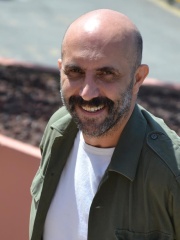
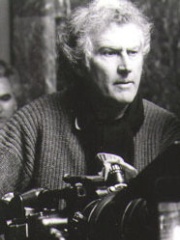
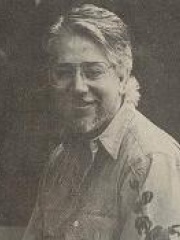
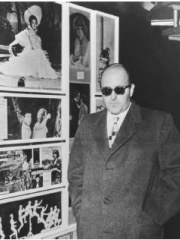
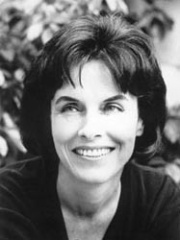
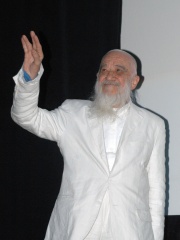
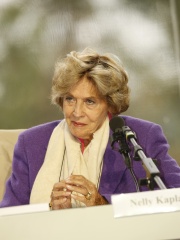
The Most Famous
FILM DIRECTORS from Argentina
This page contains a list of the greatest Argentinean Film Directors. The pantheon dataset contains 2,041 Film Directors, 15 of which were born in Argentina. This makes Argentina the birth place of the 23rd most number of Film Directors behind South Korea, and Georgia.
Top 10
The following people are considered by Pantheon to be the top 10 most legendary Argentinean Film Directors of all time. This list of famous Argentinean Film Directors is sorted by HPI (Historical Popularity Index), a metric that aggregates information on a biography's online popularity. Visit the rankings page to view the entire list of Argentinean Film Directors.

1. Héctor Babenco (1946 - 2016)
With an HPI of 63.77, Héctor Babenco is the most famous Argentinean Film Director. His biography has been translated into 31 different languages on wikipedia.
Héctor Eduardo Babenco (February 7, 1946 – July 13, 2016) was an Argentine-born Brazilian film director, screenwriter, producer and actor who worked in several countries including Brazil, Argentina, and the United States. He was one of the first Brazilian filmmakers to gain international critical acclaim, through his films which often dealt with social outcasts on the fringes of society. His best-known works include Pixote (1980), Kiss of the Spider Woman (1985), Ironweed (1987), At Play in the Fields of the Lord (1990) and Carandiru (2003). Babenco's films brought him several accolades. He was nominated three times for the Palme d'Or of the Cannes Film Festival, and was nominated for an Academy Award for Best Director for Kiss of the Spider Woman. He won the Grande Prêmio do Cinema Brasileiro twice, and the Prêmio ACIE de Cinema once.

2. Gaspar Noé (b. 1963)
With an HPI of 63.19, Gaspar Noé is the 2nd most famous Argentinean Film Director. His biography has been translated into 34 different languages.
Gaspar Noé (born 27 December 1963) is an Argentine filmmaker and screenwriter, who lives and works primarily in France. He is one of the primary exponents of New French Extremity, with his most notable works including the feature films I Stand Alone (1998), Irréversible (2002), Enter the Void (2009), Love (2015), Climax (2018).

3. Fernando Solanas (1936 - 2020)
With an HPI of 61.29, Fernando Solanas is the 3rd most famous Argentinean Film Director. His biography has been translated into 28 different languages.
Fernando Ezequiel "Pino" Solanas (16 February 1936 – 6 November 2020) was an Argentine film director, screenwriter, score composer and politician. His films include; La hora de los hornos (The Hour of the Furnaces) (1968), Tangos: el exilio de Gardel (1985), Sur (1988), The Journey (1992), The Cloud (1998) and Memoria del saqueo (2004), among many others. He was National Senator representing the Autonomous City of Buenos Aires for six years, from 2013 to 2019. Solanas studied theatre, music, and law. In 1962, he directed his first short feature Seguir andando and in 1968 he covertly produced and directed his first long feature film La Hora de los Hornos, a documentary on neo-colonialism and violence in Latin America. The film won several international awards and was screened around the world. Solanas won the Grand Jury Prize and the Critics Award at the Venice Film Festival and the Prix de la mise en scène at the Cannes Film Festival. In 1999 he was the president of the jury at the 21st Moscow International Film Festival. He was awarded a special Honorary Golden Bear at the 2004 Berlin Film Festival. He collaborated with tango composer and musician Ástor Piazzolla on the soundtracks for various movies.

4. Luis Puenzo (b. 1946)
With an HPI of 57.51, Luis Puenzo is the 4th most famous Argentinean Film Director. His biography has been translated into 19 different languages.
Luis Adalberto Puenzo (born 19 February 1946) is an Argentine film director, producer and screenplay writer. He works mainly in the cinema of Argentina, but has also worked in the United States.
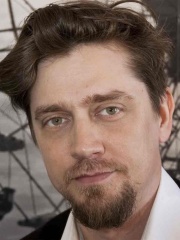
5. Andy Muschietti (b. 1973)
With an HPI of 57.29, Andy Muschietti is the 5th most famous Argentinean Film Director. His biography has been translated into 24 different languages.
Andrés "Andy" Walter Muschietti (Italian: [musˈkjeti]; born 26 August 1973) is an Argentine film director and screenwriter who had his breakthrough with the 2013 film Mama. He gained further recognition for directing both films in the It film series, the 2017 film adaptation of the Stephen King novel and its 2019 sequel, It Chapter Two. In 2023, he directed the DC Extended Universe film The Flash. In 2025, Muschietti developed and executive-produced the HBO series It: Welcome to Derry, of which he directed 4 episodes.

6. Leopoldo Torre Nilsson (1924 - 1978)
With an HPI of 54.90, Leopoldo Torre Nilsson is the 6th most famous Argentinean Film Director. His biography has been translated into 18 different languages.
Leopoldo Torre Nilsson (5 May 1924 – 8 September 1978), also known as Leo Towers and as Babsy, was an Argentine film director, producer and screenwriter. Born as Leopoldo Torres Nilsson (he later changed his paternal surname from Torres to Torre) was the son of Argentine pioneer film director Leopoldo Torres Ríos, with whom he collaborated between 1939 and 1949. He debuted in 1947 with the short El muro. His mother was an Argentine citizen of Swedish descent. His uncle was cinematographer Carlos Torres Ríos (1898–1956). Torre Nilsson's first full-length film, El crimen de Oribe (1950), was an adaptation of Adolfo Bioy Casares's novel El perjurio de la nieve. In 1954 he directed Días de odio, based on Jorge Luis Borges's short story Emma Zunz. In 1956 he directed Graciela, based on Carmen Laforet's novel Nada, winner of Nadal Literary Prize 1944. He also directed films about icons of Argentine history and culture: Martín Fierro (1968), about the main character of Argentina's national poem; El Santo de la Espada (1970), about General José de San Martín; and Güemes: la tierra en armas (1971), about Martín Miguel de Güemes. It was entered into the 7th Moscow International Film Festival. His 1973 film Los siete locos won the Silver Bear at the 23rd Berlin International Film Festival. Torre Nilsson was married to writer Beatriz Guido, whose work served as inspiration and who worked alongside him in many of his scripts. He is acknowledged as the first Argentine film director to be critically acclaimed outside the country, making Argentina's film production known in important international festivals. He died of cancer in his native Buenos Aires in 1978, at the age of 54. He was buried at the Cementerio Británico in Buenos Aires. A novelized biography of Torre Nilsson, El Gran Babsy (ISBN 950-07-0895-7), by Mónica Martín, was published in 1993. Another biography, Leopoldo Torre Nilsson: Imagen y Poesía (ISBN 987-04-0581-9) was published in 2006 by the newspaper La Nación and the Aguilar editorial house.

7. María Luisa Bemberg (1922 - 1995)
With an HPI of 54.71, María Luisa Bemberg is the 7th most famous Argentinean Film Director. Her biography has been translated into 16 different languages.
María Luisa Bemberg (April 14, 1922 – May 7, 1995) was an Argentine screenwriter, film director and actress. She was one of the first Argentine female directors with a powerful presence both in the filmmaking and the intellectual world of Latin America, particularly during her most active period, from 1970 to 1990. In her work, she specialized in portraying famous Argentine women and the Argentine upper class. Bemberg also focused on feminism, with regard to the gender debate and cinematic gaze. Her vast legacy extends to the 21st Century, with Bemberg being hailed as arguably Argentina’s foremost female director.

8. Fernando Birri (1925 - 2017)
With an HPI of 54.50, Fernando Birri is the 8th most famous Argentinean Film Director. His biography has been translated into 17 different languages.
Fernando Birri (March 13, 1925 – December 27, 2017) was an Argentine film maker and theorist. He was considered by many to be the father of the new Latin American cinema.

9. Nelly Kaplan (1931 - 2020)
With an HPI of 54.47, Nelly Kaplan is the 9th most famous Argentinean Film Director. Her biography has been translated into 17 different languages.
Nelly Kaplan (11 April 1931 – 12 November 2020) was an Argentine-born French writer and film director who focused on the arts, film, and filmmakers. She studied economics at the University of Buenos Aires. Passionate about cinema, she abruptly put her studies on hold to go to Paris in 1953 to represent the new Argentine film archive at an international convention and later became a correspondent for different Argentine newspapers. She had arrived with a resume highlighting her journalistic experience and a letter of introduction to Henri Langlois, founder and curator of the Cinémathèque Française, who introduced her to Abel Gance. Gance gave her the opportunity to work on the film La tour de Nesle. She became Gance's assistant during the film and made and showed the program Magirama (triple screen) in Polyvision, then, still at Gance's side, she collaborated with him on Austerlitz (1960). He trusted her with the direction of all the second crew's action scenes during the filming of his movie Cyrano and d'Artagnan (Cyrano et d'Artagnan, 1964). Meanwhile, she published her work about Magirama under the name Le Manifeste d'un art nouveau, with a preface by Philippe Soupault. In 1960, she published a film report entitled Le Sunlight of Austerlitz, through the Plon publishing house. Beginning in 1961, she directed an entire series of art shorts, which won numerous prizes in various international festivals. Among these shorts were "Gustave Moreau," an analysis of the 19th century symbolist painter; "Rudolphe Bresdin," the engraver; "Dessins et merveilles," on the sketchbooks of Victor Hugo, as well as "Les années 25 ", " La Nouvelle Orangerie ", "Abel Gance hier et demain ", " A la source, la femme aimée", titles based on the secret notebooks of the painter André Masson. Her first feature movie, A Very Curious Girl, was the focus of a Kaplan retrospective in 2019, Wild Things: The Ferocious Films of Nelly Kaplan. She filmed and produced a 1966 documentary, The Picasso Look, about the works of Picasso being delivered and displayed in Paris.
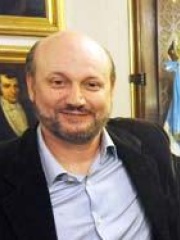
10. Juan José Campanella (b. 1959)
With an HPI of 52.79, Juan José Campanella is the 10th most famous Argentinean Film Director. His biography has been translated into 22 different languages.
Juan José Campanella (born 19 July 1959) is an Argentine television and film director, writer and producer. He achieved worldwide attention with the release of The Secret in Their Eyes (2009), for which he was awarded the Academy Award for Best Foreign Language Film.
People
Pantheon has 15 people classified as Argentinean film directors born between 1922 and 1975. Of these 15, 9 (60.00%) of them are still alive today. The most famous living Argentinean film directors include Gaspar Noé, Luis Puenzo, and Andy Muschietti. The most famous deceased Argentinean film directors include Héctor Babenco, Fernando Solanas, and Leopoldo Torre Nilsson.
Living Argentinean Film Directors
Go to all RankingsGaspar Noé
1963 - Present
HPI: 63.19
Luis Puenzo
1946 - Present
HPI: 57.51
Andy Muschietti
1973 - Present
HPI: 57.29
Juan José Campanella
1959 - Present
HPI: 52.79
Lucrecia Martel
1966 - Present
HPI: 52.50
Sebastián Lelio
1974 - Present
HPI: 47.79
Damián Szifron
1975 - Present
HPI: 47.47
Pablo Trapero
1971 - Present
HPI: 46.03
Lisandro Alonso
1975 - Present
HPI: 41.01
Deceased Argentinean Film Directors
Go to all RankingsHéctor Babenco
1946 - 2016
HPI: 63.77
Fernando Solanas
1936 - 2020
HPI: 61.29
Leopoldo Torre Nilsson
1924 - 1978
HPI: 54.90
María Luisa Bemberg
1922 - 1995
HPI: 54.71
Fernando Birri
1925 - 2017
HPI: 54.50
Nelly Kaplan
1931 - 2020
HPI: 54.47
Overlapping Lives
Which Film Directors were alive at the same time? This visualization shows the lifespans of the 6 most globally memorable Film Directors since 1700.

